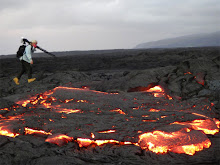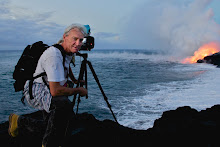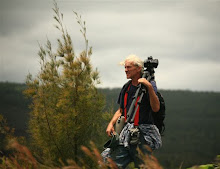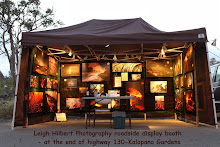 The photo above was taken from the Hawaii County lava viewing road parking area on highway 130 at 10:00 PM last night. (Click on any of the images to open a larger view window)
The photo above was taken from the Hawaii County lava viewing road parking area on highway 130 at 10:00 PM last night. (Click on any of the images to open a larger view window)The 350 visitors who drove down to the Hawaii County viewing area road-walk enjoyed a beautiful afternoon walk along the road, many gathered at the high spot on the road at dusk and into nightfall to watch the pali lava glow come on.
This surface lava is being fed by lava tubes from the TEB eruption site far above the edge of the pali where the lava is resurfacing as A`a and pahoehoe breakouts from the 1900 and 1600-foot elevation.
A 3.6 earthquake shook the southeast coast of the Big Island at 8:55 this morning, six-miles northwest of Ka`ena point and at a depth of 21-miles:

Halema’uma’u Crater has been going through cycles of varied lava levels within the crater’s eruptive pit vent, which has often manifested during the day with distinct changes in its sulfur dioxide plume strength (and varied glow brightness at night). The two photos below, captured directly from the USGS/HVO cam demonstrate this well:
Below: May 22nd, 2010

 Above: Today, June 29th, 2010
Above: Today, June 29th, 2010As I have posted before; there are no active lava breakouts on coastal flats and no ocean entry lava at this time, but there has been some new heat arriving into the April-May Quarry flow field and manifesting visually when ocean waves break onto the new lava shoreline creating steam where there recently was none. It is very likely that the Quarry flow lava plumbing system is being re-energized by molten lava further up the mountain, which could further lead to a reemergence of lava within the coastal flats flow fields.
I will update these blog postings next when there are some significant changes or newsworthy reports to offer you :)
Active lava viewing prospects for the public:
1) The Halema’uma’u crater has been degassing sulfur dioxide fumes by day and glowing strongly at times after dark from lava deep within the craters pit vent. The broiling molten lava moves up and down inside this massive eruptive vent by hundreds of feet at times, in kind of a pistoning action. This raising and lowering of lava has the potential to breach the floor of the crater and likely will do so in the future. Great views of this impressive crater are from the Jaggar Museum balcony within the Hawaii Volcanoes National Park, depending on the weather; and the park is open to the public 24 hours a day with a nominal entrance fee by day..
2) Coastal viewing: A one mile walk to the very end of highway 130; this is the same location where lava came onto the highway there on May 5th, 2010 but the lava there has now cooled, though is still hot a short distance away. The lava fuming/degassing can be seen coming down the distant pali during the day. After dark lava glow can possibly be seen in two or three places high atop the mountain slopes.
Official viewing hours are from 2:00 PM until around 9/9:30 PM - everyday, with last car allowed in at 8:00 PM. On site are security personnel, a few port-o-potties at both the parking lot and at the end of the road, vendors occasionally have drinking water and flashlights but it is best to bring both these things with you and also some decent walking shoes. The road is open to all traffic on all other hours.






























